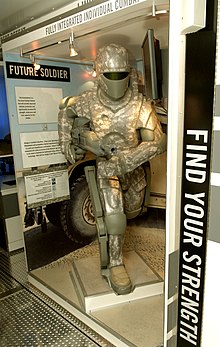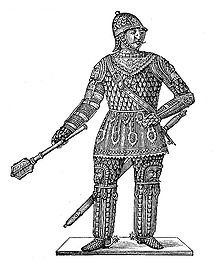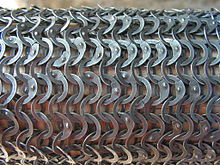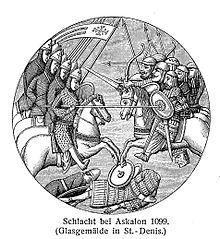Body armor
![]()
This article is about historical protective clothing. For other meanings, see Armor (disambiguation).
.jpg)
Armor is the term used to describe historical protective clothing that is primarily intended to protect its wearer from the effects of weapons and against wounding. Armor has been in use for thousands of years and was made from a wide variety of materials and using different methods. The most common armor in the European Middle Ages was made of textile (gambeson). The best available armor was a warrior's protection for the chest (harness), neck (collar), arms (bracers, gauntlets), and legs (greaves, iron shoe), consisting of rings (chain armor) or, from the late Middle Ages on, metal plates (plate armor). Armor is still worn today in various fields, including police and military (bulletproof vest). The helmet, as probably the most important part of armor, is highlighted in its own article. The shield, although it has been the most important protective equipment for most fighters, does not count as armor.
Even animals used in battle (fighting dogs, war horses, war elephants) were partly protected by armour. The knight's horse wore pieces of armor for protection, such as horse brow, front stirrups, loin armor and the like.
Armor Types
Examples of prehistoric, ancient, medieval and early modern armour:
- Textile armour, gambeson
- Leather armor
- Bell Armour
- Flap armour
- Muscle armor
- Harness
- Lamella armour
- Scale armour
- Chain armor
- Rail or clasp armour
- Brigantine
- Record Rock
- Plate armour
- Sting and race stuff
- Japanese Armor (Yoroi)
- Silk quilted armour (Mongolian warfare)
Especially since the late Middle Ages plate armour appeared, which was suitable for a certain use, see: Types of plate armour.
Protective clothing is also used today, usually made of special fibers such as Kevlar, hard plastic or ceramic.
· 
Plate armour in the Zwinger in Dresden
· 
Armour in the Graz Armoury
·
Horse armour in the Kunsthistorisches Museum in Vienna
· 
Dog armour from the 17th century in the Wartburg armoury
History and development
Oldest forms
All beginnings of the armor fall back on natural products. One used tree bark, the fur or bones and horn parts of the hunted prey. The further development of the armor aimed at increasing the strength, coupled with greater freedom of movement. This was achieved by multiplying the individual layers of the material, by reinforcing it with horn, wood or metal plates, by placing the scales next to each other and on top of each other in a more flexible way, and by using armour made of straps, cords, individual rods, etc. Finally, metal was used. In conclusion, metal was used. There is evidence of these early forms of armour in the form of finds or faithful reproductions in museums.
These oldest forms of armor can be found in some cases among indigenous peoples even into the near past.
- Tree bark armor with horn scale coating among the Bugi on Sulawesi. Beautifully decorated tree bark armour in the form of wide belts, which were tied incredibly tightly around the waist, was common in New Guinea.
- Cotton war skirts from the African regions of Gourma, Dagomba and Mossi in northern Togo with sewn-on, very tight leather pouches.
- Cotton wool armour existed in former times in America (Aztecs etc.), but also in the central Sudan; made of rattan
- Woven armor is worn on the north coast of New Guinea, and armor made of coconut fiber mesh is worn in the Gilbert Islands.
- Rod-armor In a more primitive imitation of these Japanese armors from rods and slices of walrus-teeth, bones, wood etc. caused by the more scantily available aids, then also the peoples of northeast-Asia and North America wrapped themselves in former times.
- Fur cuirasses were common in equatorial Africa from Albert Nyanza to Shari.
· 
Tlingit Indian carapace of wood or bone plates and sticks
· 
Armor made of natural materials of a warrior of the Micronesian island Nauru
Ancient
Assyrian and Chaldean soldiers wore a shirt-like armor as early as 710 BC, the metal scales of which were sewn onto buffalo skin. For the lightly armed, the protection reached to the waist. For the heavily armed soldiers, it covered the neck and upper arm and extended to the feet. Greaves covered the front of the leg up to the knee. In Egypt, in addition to leather armour, which was often reinforced with broad metal bands (breastplates), armoured shirts made of bronze scales 20 to 25 cm in size and arm and leg splints made of bronze occur as early as 1000 BC. Such scale armour was also common among the Parthians, Persians and Sarmatians and spread from them throughout the Orient. Around this time, the Greeks wore bronze breast and back armour, each forged from one piece or consisting of roof tile-shaped sliding plates, as well as greaves (knemids) on both legs, like the Etruscans.
Among the Romans, the velites (lightly armed infantry), like the Samnites and the gladiators modeled on them, wore greaves (ocreae) on the left leg, while the heavily armed (hastati) wore greaves (ocreae) on the right leg, the leg placed in front during combat. The scale armour (lorica squamata or lorica plumata) consisted of scales of metal, bone or horn, after the form of fish (round) or snake (diamond-shaped) scales, or of bird feathers, attached to leather or canvas by leather straps or wire. The heavily armed horsemen, who in the earliest times formed the nucleus of the army, were clad up to the feet and hands in such scale armour. At the time of the Republic the Hastati already wore armless ring armour (lorica hamata) reaching only to the hip; about the year 160 B.C. the Principes had ring armour, while the Hastati and Triarii had breastplates of moderate size (pectorale). From the beginning of the 1st century AD there is evidence of an additional armour composed of steel bands of different widths covering the waist and shoulders (lorica segmentata). This armour did not replace the more widespread ring armour and could not prevail among the cavalry either. In addition there were for the army leaders, consuls, emperors etc.. The armour was possibly forged from sheet iron or bronze, adapted to the body and decorated with reliefs, gilding and other ornaments.
In the Kofun period, the Japanese developed Tankō armor. This armor was made of sheet iron and tanned leather.
· 
Roman breastplate adapted to the body, ceremonial armour of Roman military leaders, consuls, emperors (marble column of Germanicus in the Lateran Museum in Rome)
· 
Germanic (Carolingian) foot fighter with a scaled covering (cowl) covering the neck and upper arms.
Medieval
→ Main article: Armament and equipment of medieval foot soldiers
Throughout the Middle Ages, the most common type of armor was textile armor. For simpler fighters as the sole armor (gambeson or acetone) or in addition to a metal armor either as padding underneath, or as additional protection above. These textile armors could differ significantly in construction and material. Usually linen or cotton was sewn in many layers on top of each other, sometimes also quilted with padding material. In the case of armour for the upper classes, the armour was also covered and embroidered with more precious materials such as silk. Textile armour could also be worn under the helmet (coiffe).
Leather as an armour material is highly controversial for (Western) Europe, except as a support material for metal plates. Only in a few textual sources are there references to the use of leather (cuir bouilli or magical seal skins in an Icelandic saga).
Already in the early Middle Ages, the ring armor shirt was the most common armor for wealthy fighters. In the early Middle Ages, the ring armor shirt usually covered only the torso up to the thighs, as well as the upper arms. This was sometimes accompanied by a hood made of chain mesh or a chain collar attached to the helmet. With the High Middle Ages the ring armour covered larger and larger parts of the body, gloves and hood were integrated. In addition, there were leg warmers made of chain mesh, which were either attached to the doublet or to a special armour belt. Especially in combination with textile armor, this type of armor offered very good protection against most weapons of the time.
Less common in the early and high Middle Ages was the scale armor. So far, this type of armour has only been documented in written and pictorial sources, especially for the armoured riders of the Franks. A further or parallel development of the scale armour is the lamellar armour. This can only be found in a few finds in Western Europe, mostly in an Eastern European or Asian context.
With the further development of weapon systems (more powerful crossbows, mounted attack with inserted lance), as well as advances in metal processing technology, the ring armor shirts were supplemented by other armor parts in the late High Middle Ages. These armours (Plattenrock, Lentner, Brigantine) consisted of metal plates, which were sewn or riveted onto a carrier material and offered additional protection to the torso.
In parallel, with the beginning of the late Middle Ages, plate armour emerged, which could protect larger and larger parts of the body more effectively. Influential armor centers that shaped their own armor styles were Nuremberg and Augsburg in today's Germany, and Milan in Italy. Other countries also developed their own armour centres, some with their own characteristic style, which were usually led by German or Italian masters.
Characteristic for Milanese armour were the round, massive shapes, as well as the asymmetrical construction. Also, under the Milanese armor was usually worn a complete chain mail. In Germany the Gothic armour was predominant, as well as later the Riefelharnisch. The gothic harness was characterized by its slimmer and more filigree construction. In addition, a complete chain mail shirt was rarely worn under the gothic armour, more often chain mesh parts were attached to the armour doublet in such a way that they covered the weak points of the armour. The Riefelharnisch gets its name from the grooving of the surface. In addition to the decorative element of this grooving, it was also possible to achieve greater stability with less or the same weight. This advantage was bought by a significantly more expensive production.
English armor was more optimized for fighting on foot than its continental counterparts and almost completely encased the body in metal plates. The armour on the European mainland was worn to a much greater extent by horsemen and therefore could not or did not have to provide equivalent protection for certain parts of the body (for example, the inside of the legs was at most protected with chain mesh, since on the one hand the horse offered protection there, and on the other hand this could not be chafed by the plates).
In addition to military armor, armor for tournaments was used in a more athletic context. These armors could become significantly heavier and more immobile than their military counterparts. The heaviest armors made were those for Gestech (tournament, also known as tail race, suit race, Welsches Gestech, Geschiftrennen, or Scharfrennen). For these tournaments, mostly already existing armour was equipped with additional armour plates and reinforcements on the head, chest and arms. These reinforcements were so exaggerated that some armour could hardly be used. Their weight was in some cases up to 80 kg. However, these harness armors should not be confused with general armors. They are not to be used for combat or warfare. This armor was also commonly called stabbing armor. The armor made the rider heavy and clumsy and the horses were no longer able to perform the so-called chok - a military attack maneuver of the cavalry - because of the load to be carried. Furthermore, the horses now fell more easily in battle.
Modern Times
With the increasing spread of firearms, the armor became more massive, helmets and breastplates partly bulletproof. Due to the increasing weight of the individual pieces of armor, the armor covered less and less parts of the body, until in Napoleonic times only heavy cavalry (cuirassiers) wore a breastplate.
At the beginning of the 20th century, there was a brief period of increased experimentation with armour in the trench warfare of the First World War, until it disappeared altogether. Nowadays, combat suits with bullet-resistant components made of ceramic, metal or Kevlar are used in the military sector. These protect against (shell) splinters and projectiles, up to a certain kinetic energy. These armours are also used by the police. The fact that the development of armor for infantry units is continuing is shown, for example, by concepts from NATO's Future Soldier program.

Concept of an exoskeleton armor of the US Army

Emperor Maximilian I (1459-1519) in ceremonial armour
.jpg)
Full plate armor as it existed in the early 16th century.
.JPG)
Knight in armor and weapons

Polish knight 16th century, armored up to the feet

Ringed armour was the precious armour of wealthy knights. (Ring armour made of individually forged and riveted rings).

From the 10th century onwards, knights wore longer armoured shirts. (Battle of Ascalon 1099, stained glass in St Denis. The knights on the left, the Egyptians on the right)
Questions and Answers
Q: What is modern body armour?
A: Modern body armour is protective clothing designed to absorb and/or deflect slashing, bludgeoning, and penetrating attacks.
Q: Who uses modern body armour?
A: Modern body armour is used by soldiers, riot police, private security guards and bodyguards.
Q: What are the two different types of modern body armour?
A: The two different types of modern body armour are regular non-plated personal armor used by most police, security guards and bodyguards; and hard-plate reinforced personal armor which is used by combat soldiers, police tactical units and hostage rescue teams.
Q: How long has modern body armour been around for?
A: Armour has certainly been around for a long time but it was little used in infantry warfare until the 18th century.
Q: What materials are suitable for light effective armour?
A: Carbon fibre, modern hard ceramics and various plastic compounds are suitable for light effective armour.
Q: What type of material is Kevlar?
A: Kevlar is an aramid which is a long-chain aromatic polyamide. It is often used to make bullet resistant vests or face masks.
Q: How do items made with Kevlar provide protection from weapons?
A: Items made with Kevlar provide protection from weapons due to their lighter weight as well as increased stopping power compared to other materials.
Search within the encyclopedia
